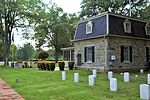Richmond National Battlefield Park
1936 establishments in VirginiaAmerican Civil War museums in VirginiaBattlefields of the Eastern Theater of the American Civil WarHistoric districts on the National Register of Historic Places in VirginiaMuseums in Richmond, Virginia ... and 10 more
NRHP infobox with nocatNational Battlefields and Military Parks of the United StatesNational Park Service areas in VirginiaNational Register of Historic Places in Hanover County, VirginiaParks in Chesterfield County, VirginiaParks in Henrico County, VirginiaParks in Richmond, VirginiaProtected areas established in 1936Richmond National Battlefield ParkVirginia in the American Civil War

The Richmond National Battlefield Park commemorates 13 American Civil War sites around Richmond, Virginia, which served as the capital of the Confederate States of America for most of the war. The park connects certain features within the city with defensive fortifications and battle sites around it.
Excerpt from the Wikipedia article Richmond National Battlefield Park (License: CC BY-SA 3.0, Authors, Images).Richmond National Battlefield Park
Maintenance Way,
Geographical coordinates (GPS) Address Nearby Places Show on map
Geographical coordinates (GPS)
| Latitude | Longitude |
|---|---|
| N 37.429166666667 ° | E -77.373611111111 ° |
Address
Maintenance Way 1990
23231
Virginia, United States
Open on Google Maps









